UAS4STEM Takes Flight
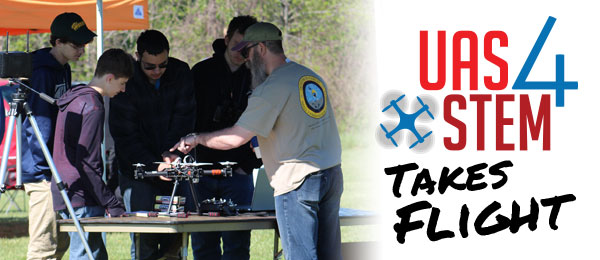
Written by Rachelle Haughn New UAS contest for youth kicks off Digital exclusive feature Photos by Tara Stafford and Matt Ruddick As seen in the June 2016 issue of Model Aviation Digital.
UAS4STEM Regional Recap
A small group of hikers has gone missing in a remote area. Rescuers have determined the search area, but are unsure of the hikers’ exact locations or conditions. Because of the terrain, looking for them on foot would be treacherous and take several hours. Searching via an all-terrain vehicle is possible, but there is only one available. Darkness is coming fast, and the temperature is expected to dip into the low 30s tonight. At this point, the person heading the rescue operation must come up with a quick plan of action. It would be helpful to be able to view the area from the sky, but the closest Cessna cannot arrive until two hours from now. There must be a better and more efficient way to look for the missing people before darkness arrives … A scenario similar to this is what students ages 11 to 19 were given shortly before they powered up the transmitters for their Quadzilla multirotors on a Saturday morning in April. The groups of four to eight youths were competing in AMA’s inaugural regional UAS4STEM competition. They were tasked with using the quadcopters and FPV equipment to find clues that would lead them to the missing hikers (which was actually a dummy). The contest was held April 23-24 in Hollywood, Maryland, and hosted by the Patuxent Aeromodelers club. In the months leading up to the contest, the 17 teams were tasked with completing an online curriculum that included safety and flight training, building information, and aircraft programming; and building Quadzilla quadcopters.
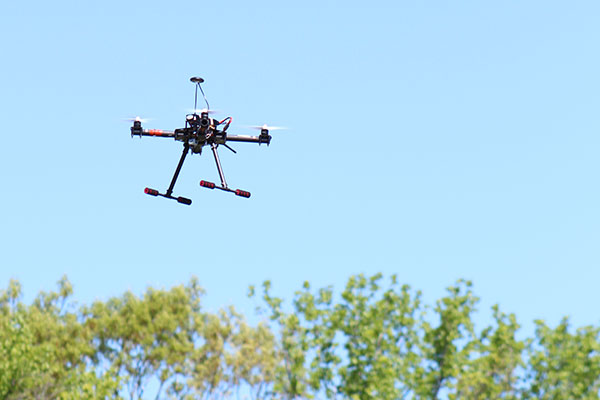
Teams participating in the contest were required to build Mid-Atlantic Multirotor Quadzilla quadcopters from a frame kit.
Before preparing for the contest, the students at the first of six UAS4STEM regional competitions had never flown, built, or been exposed to any RC aircraft, including multirotors, said Bill Pritchett, AMA Education director. “This is brand new to them and some had never used tools before,” Bill stated. “I think it’s a huge opportunity for us to tie this new technology into education for the kids.” The teams were evaluated by some Patuxent Aeromodelers club members who served as judges. The competitors received points for an oral briefing that they had to present before their flights, meeting the requirements of the flight mission, completing autonomous flight tasks, and finding the mystery items. The autonomous flight tasks included takeoff, landing, accurately displaying the “no-fly-zone” boundaries, and waypoint navigation. The team with the most points won.
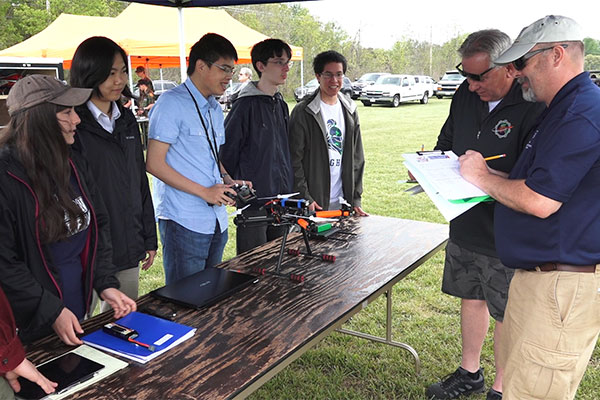
As part of the competition, the teams had to explain to a panel of judges how they planned to complete the mission.
After conducting their preflight inspections, the pilots had to fly above the assigned search area and find items that could help them locate the missing hikers, such as a cooler, a lawn chair, and a tent. Most of the teams used some sort of search pattern to find these objects. The locations of the items were called waypoints. When these things were found, the team members used GPS and computer software to mark the waypoints. The aircraft had to hover at each waypoint for a minimum of 5 seconds. Jessy Symmes, AMA Education assistant, said she asked some of the teams what they based their search patterns on. She said one of the Civil Air Patrol (CAP) teams used a pattern similar to one used by the Navy, another implemented one commonly utilized by aerial firefighters, and a third used trigonometry. “They would fly over [the area] until they found the first item, then they used trigonometry to find the next. They found all of the items,” Jessy added. Other teams didn’t have a search pattern to follow. “Some just did hunt-and-peck,” she said.
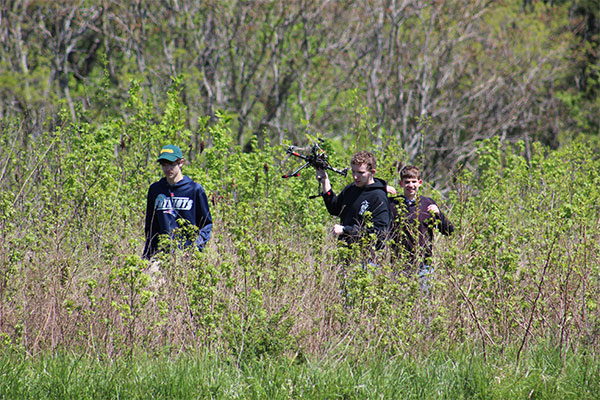
One of the terrain problems that a search-and-rescue team on foot would have encountered is this tall brush. In the case of an aerial search operation, however, it cushioned the landing of this Quadzilla that was recovered by one of the UAS4STEM teams.
The Maryland regional contest was held from 8 a.m. to 3 p.m. each day. Most of the competitors lived two hours or fewer away. Some of the teams’ entry fees were funded by the Naval Air Station Patuxent River, which is located near the Patuxent Aeromodelers club’s flying site where the contest was held. Bill said these teams were from high schools near the naval base, and 1/3 of the participants were females. Jessy said that the teams participating in the upcoming regional contests included some made up of five kids who live in the same neighborhood, a group of boys trying to earn their Eagle Scout badges, a group of homeschooled brothers and sisters, and some students who met in a class and decided to form a team. The other five regionals were scheduled to be held April 30 to May 1 in White Lake, Michigan; May 7-8 in San Diego; May 21-22 in Ball Ground, Georgia; June 3-4 in Fargo, North Dakota; and July 23 in Wenatchee, Washington. A total of 75 teams registered to compete in the regionals. Jessy said that AMA had hoped to have 15 to 20 teams participate in the first year of the contest. “Never in our wildest dreams [did we think] we would have 75 teams,” she said. Jessy added that the number of teams had to be capped at 75 because AMA employees ran out of time to get the quadcopter kits delivered to the teams fast enough to allow enough time for the students to build the aircraft. This is the first year for UAS4STEM, but a similar contest, called STEM4UAS, was held in 2015. It was developed and operated by the Navy, with assistance from AMA member Archie Stafford, Bill explained. “It kind of fell apart. There were equipment failures and the kids were frustrated because there was not enough flying time,” he said. The teams used BNF multirotors for the 2015 regional event, which was also held in Maryland. “We took charge and got a website and started developing the AMA version of that,” commented Bill. This year, Archie is a contracted AMA employee and holds the dual titles of national director UAS4STEM and AMA Education sUAS specialist. The Naval Air Systems Command pilot and his fellow Patuxent Aeromodelers club members were able to help the contestants when needed. In addition to being judges, some of the Maryland club’s members served as safety inspectors. They also put on a noontime flight demonstration of model helicopters and airplanes. Bill said roughly 25 of the club members live at the naval base.
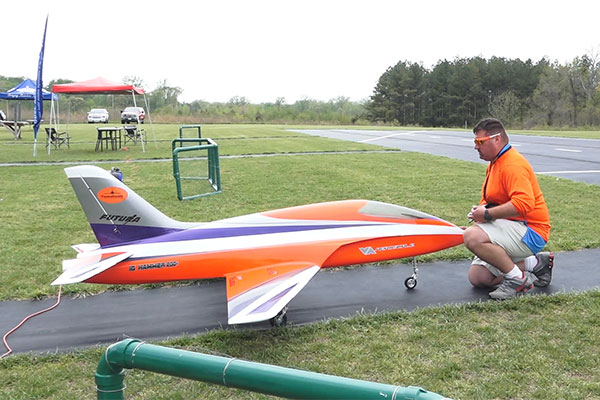
The host club for the first UAS4STEM regional contest, the Patuxent Aeromodelers, put on a flight demonstration to expose the participants to a variety of model aircraft including helicopters and airplanes. Archie Stafford, who is the national director UAS4STEM, AMA Education sUAS specialist, and a member of the Patuxent Aeromodelers club, is shown here, getting his aircraft ready to fly.
The Maryland club isn’t the only one that has stepped up to the plate for UAS4STEM. Jessy and Bill had plenty of praise for all of the clubs that were planning to host regionals. “This wouldn’t be possible without the AMA clubs that have stepped up and gone above and beyond” what was asked of them, Jessy said. “It’s a lot to ask for. They’re putting this whole show on themselves.” Other clubs that volunteered to host the regional contests have invited local media to the events, have asked colleges to come and speak to the students about their aeronautical programs, plan to cook meals for the youth, and have made grab bags for them to take home, Jessy stated. When asked how he felt about how the first regional UAS4STEM contest went, Bill said, “Oh, two thumbs up!” Jessy felt the same. “It went way better than expected.” Bill added that the students seemed to enjoy the contest. “When we were giving out the certificates, I asked them if they learned anything. [They answered] yes. [I asked] did you have fun? ‘Yes.’ Will you come back next year? ‘Absolutely!’” The top two teams in each regional will be invited to compete in the national contest. The teams from the Maryland regional that have been invited to the national contest are TORCH and St. Marys Composite Squadron (CAP) MD089. The national competition will be held August 20 at the International Aeromodeling Center, located at AMA Headquarters in Muncie, Indiana. In addition to these 12 teams, of the six teams that took third place in the regionals, the one with the fastest time will also be invited to participate in the national contest.
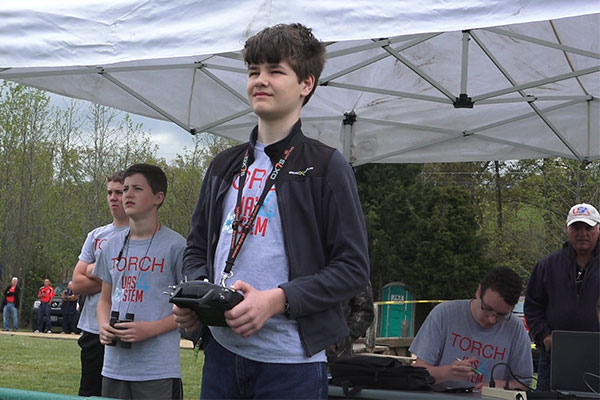
The TORCH team was one of the top finishers in the regional UAS4STEM contest that was held in Maryland.
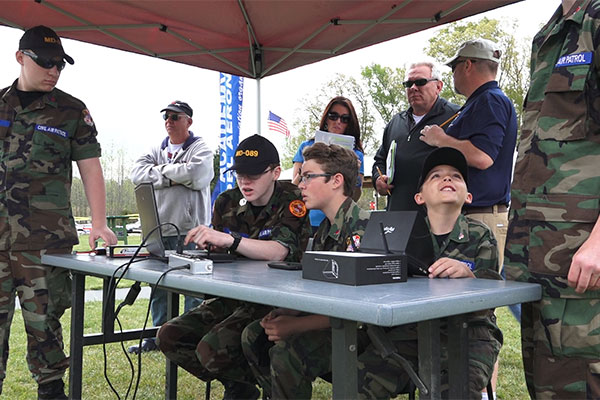
This Civil Air Patrol team, MD-089, finished in the top two in the regional UAS4STEM contest. The team has been invited to participate in the national competition in August. Pictured in the back row is Jessy Symmes, AMA Education assistant.
At the national UAS4STEM contest, the winning team will receive scholarship money. Also, one of the competitors will be selected as the first-ever recipient of the Dewey O. Broberg Jr. Memorial Scholarship. The recipient will be chosen by the contest judges based on his or her demonstration of teamwork. Although the team registration period has ended for the 2016 contest, teams can register for the 2017 contest beginning June 1 at www.uas4stem.org. —Rachelle Haughn [email protected]










Add new comment